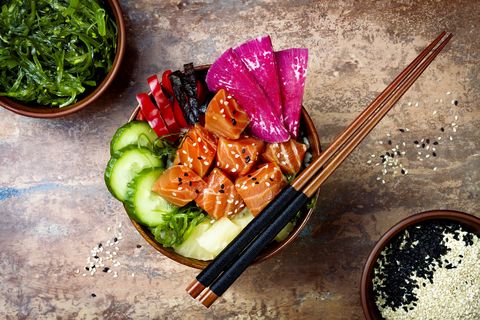Easy Recipes for Cooking Salmon in the Oven
Nutritionists don't call it "brain food" for nothing. Salmon contains a crucial compound called docosahexaenoic acid that helps maintain the central nervous system, not to mention all of the boosts this fish gives your heart and metabolism. Here's why salmon needs to become part of your weekly dinner rotation, stat:
Nutrition Stats
Serving Size: 4-ounce sockeye salmon fillet
- 170 calories (70 calories from fat)
- 6 g total fat
- 1 g saturated fat (5% DV)
- 75 mg cholesterol (25% DV)
- 26 g protein
- 20 mg calcium (2% DV)
- 0.27 mg iron (4%)
More From Good Housekeeping

Health Benefits of Salmon
As a rich source of omega-3 polyunsaturated fatty acids, eating salmon has beaucoup advantages. Serving up this fish can:
- Reduce inflammation: Omega-3 fatty acids in salmon increase cell membrane fluidity, helping inhibit inflammation.
- Help burn fat: Omega-3's can also improve fat metabolism and reduce your body's production of triglycerides (a type of fat).
- Make your kids smarter: The DHA in salmon is a major structural component of the central nervous system and retinas. The Food and Drug Administration (FDA) found that salmon is among the types of fish that could provide a child with an additional 3.2 IQ points by age 9 if consumed during pregnancy.
- Control blood sugar and blood pressure: Research has shown that bioactive peptides in salmon proteins may help keep these numbers in check.
- Protect your heart: Eating salmon regularly may improve your lipid levels and reduce cardiovascular disease risk.
Now that you're convinced of salmon's super powers, here's what you need to know about buying and preparing the best seafood.
Which type of salmon is best?
Chinook (farmed and wild), coho, and sockeye salmon all contain significantly more n-3 fatty acids than n-6 fatty acids — a key nutrient ratio linked to reducing oxidative stress on your body. That's the type that causes inflammation and ultimately can lead to chronic disease. Out of the three, chinook has the greatest content of n-3 and n-6 fatty acids, then sockeye, then coho.
How is organic salmon different?
The United States Department of Agriculture (USDA) currently does not certify seafood as "organic," but it's working on developing standards to do so. Accordingly, any fish (including salmon) currently sold as "organic" is imported and labelled according to international farming and feeding standards.
What's the difference between farmed and wild?
The FDA holds farmed (a.k.a. "aquacultured") and wild-caught fish and shellfish to the same food safety standards. Both farmed and wild seafood provide lots of proteins, omega-3 fatty acids, key vitamins, and minerals. However, they may differ in their fatty acid content. For instance, farm-raised chinook salmon has been shown to have more omega-3 fatty acids than wild Alaska chinook.
And canned versus fresh?
Canned salmon and other fish still provide the same nutritional benefits as fresh fish but it's generally more cost-effective if you're on a budget.
What about genetically engineered salmon?
The FDA has approved AquAdvantage Salmon, a genetically engineered Atlantic salmon. It concluded it's "as safe to eat as any non-genetically engineered (GE) Atlantic salmon, and also as nutritious."
Should I eat salmon while pregnant? What about mercury?
The potential negative effects of methylmercury in fish are far smaller than the adverse effects of eating too little fish. The FDA has created three categories to help pregnant women select fish to eat while expecting: "best choices" (eat two to three servings a week); "good choices" (eat one serving a week); and "fish to avoid." Salmon falls into the "best choices" category.
Can you eat salmon skin?
Salmon skin is super nutrient-dense; it's got all of the omega 3's, plus vitamin D and a slew of key vitamins and minerals. Try poaching, grilling, and broiling with the skin on, which will help your filet stay intact while you cook. You can always remove it before you dig in if you don't love the flavor.
How should I prepare it?
Baked, broiled, sauteed, canned, or raw, there are many ways to enjoy salmon! However, if you're pregnant or immunosuppressed, consult with your doctor before consuming raw seafood. Looking for some ideas? Try five of our favorite recipes:
- Seared Salmon With Lentil Salad
- Honey-Ginger Cedar Plank Salmon
- Spiced Salmon With Sweet 'n' Tangy Slaw
- BBQ Salmon and Brussels Bake
- Salmon With Skyr and Sauteed Kale
A registered dietitian with a Bachelor of Arts degree from Northwestern University and a Master of Science degree in Clinical Nutrition from New York University, Jaclyn "Jackie" London handled all of Good Housekeeping's nutrition-related content, testing, and evaluation from 2014 to 2019. Prior to joining GH, she was a clinical dietitian at Mount Sinai Hospital. Jackie has also appeared as an expert guest on The Dr. Oz Show and The Today Show. She is also author of the book Dressing on the Side (and Other Diet Myths Debunked).
Source: https://www.goodhousekeeping.com/health/diet-nutrition/a19503650/salmon-nutrition/


Postar um comentário for "Easy Recipes for Cooking Salmon in the Oven"